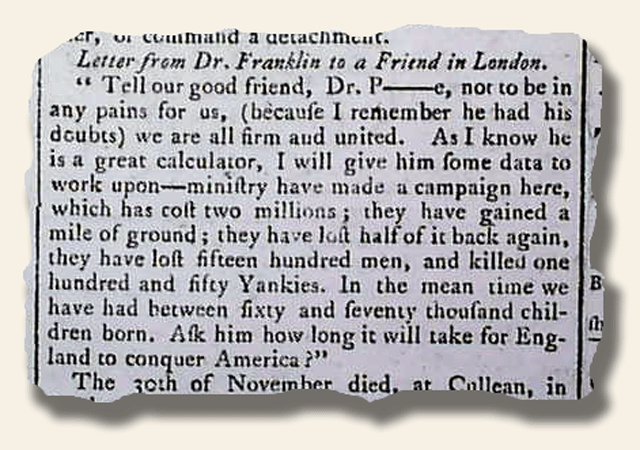Gentleman’s Magazine: a little gem packed with history…
December 27, 2013 by TimHughes · Leave a Comment
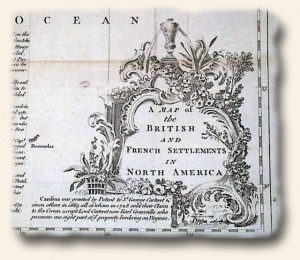
As dealers we have been very true to our focus on rare newspapers, and—for the most part—only newspapers. Yes, we have ventured into the occasional old document, pamphlet, colonial currency and the other items I’ve found intriguing, but otherwise we offer only historic newspapers.
But one big exception has been 18th century magazines. As is likely the case with most collectors of history, the over-riding aim is to find historic news reports dated as early as possible, and the availability of newspapers runs quite thin before 1760 (the London Chronicle dates to 1755 and is the single biggest source of period reports back to this period) if British titles are accepted, and only back to about 1787 if American newspapers are the only option.
It was many years ago that I discovered one of the best titles of the 18th century for period news reporting, and it wasn’t even a newspaper. It is a magazine. More specifically, “The Gentleman’s Magazine” from London. Having begun in 1731, its pages captured news reports concerning America which could never be found in period American newspapers, and rarely found in period British newspapers. From its earliest years “The Gentleman’s Magazine” printed reports on the creation of the colony of Georgia, the founding of the town of Savannah, with many issues mentioning James Olgethorpe. From 1736 are reports of William Penn laying out the city of Philadelphia, and the 1730’s has several reports of pirates operating in the Caribbean and the Atlantic, as well as famous highwayman Dick Turpin. Slave revolts in Jamaica, “Customs of the Jews” and other smaller reports from the American colonies round on the 1730’s.
The 1740’s have several items on the slavery issue which would be a topic of discussion on both sides of the Atlantic well into the 19th century. And relating to slavery are several issues of the 1770’s on famous slave/poet Phillis Wheatley.
There are early reports on the sport of cricket, and much on the Jacobite Rebellion including mention of “Bonnie Prince Charlie”. Other curious reports from the 1740’s include text on Handel and his “Messiah”, Ben Franklin mention with various electricity experiments, the death of astronomer Edmund Halley, the origin of the game of chess, and a curious item on a northwest passage to China through Canada. Military events in periodicals are never-ending, and this decade prints the text of the Treaty of Aix la Chapelle, among many other military events.
The 1750’s are highlighted by much reporting on the French & Indian War between the French & the British, with mention of Quebec, Crown Point, Fort DuQuesne and all the other major battle sites. Keep in mind that the American colonies were British possessions at the time so there was much interest in
“The Gentleman’s Magazine” has nice reporting on Ben Franklin’s lightening rod experiments, and there is also a terrific—although inconspicuous—mention of what would become known to all Americans as the Liberty Bell. Under the heading: “America” and with a “Philadelphia, May 10” dateline from 1753 is a report reading:

“Last week was raised and fixed, in the State-House Steeple, the great bell, weighing 2080 lb. cast here, with this inscription,
‘Proclaim liberty throughout all the land, to the inhabitants thereof.” This is how they reported the installation of what would become known as the Liberty Bell.England in reporting events relative to the colonies. A special feature of Gentleman’s was their very early mention of George Washington, a Major in the Virginia military in 1754 and 1755 when he lead others into battle in Pennsylvania. Such mention of Washington in an American newspaper would result in a price well beyond the budget of most collectors.
The 1760’s in “The Gentleman’s Magazine” are highlighted by the growing tensions between the colonies and England. The full text of the hated Stamp Act is found within its pages, and just a year later is found the formal repeal of the Stamp Act by the British King. Other Acts of Parliament harmful to colonial relations are reported as well.
News from the 1770’s begin with the Boston Massacre (and the trial details of those involved), reported in Gentleman’s in nice detail. All the events of the Revolutionary War received excellent coverage, from the Boston Tea Party to Lexington & Concord, the Battle of Bunker Hill, Saratoga, White Plains, Ticonderoga, Cowpens, Guilford Court House and the other military initiatives of the war with considerable mention of George Washington, Gage, Gates, Burgoyne, Ethan Allen, Howe, Greene, Cornwallis, John Paul Jones, and others. There is even much detail on the infamous Benedict Arnold/Major Andre treason.
Historic documents are found within the pages of “Gentleman’s Magazine” as well, including the Articles of Confederation, the “Causes & Necessity for Taking Up Arms”, the Constitution of the United States (in 1787), and the most desired document of all, the Declaration of Independence. At a time when a period printing of the Declaration in an American newspaper will sell for over a quarter of a million dollars, to be able to purchase a 1776 magazine with a timely printing of the Declaration of Independence for under $4000 is a rare opportunity for any collector.
The 1780’s begin with the closing events of the Revolutionary War, including the surrender of Cornwallis to Washington at Yorktown, Virginia, and shortly thereafter the formal text of the Treaty which ended the Revolutionary War. There are reports on Captain James Cook’s famous voyages of exploration, the obituary of Benjamin Franklin, and with attention focusing more on European reports later in the decade are reports of the fall of the Bastille and the French Revolution, and into the 1790’s with the mutiny on the Bounty, the guillotine execution of Louis XVI and Marie Antoinette, then into the early 19th century with the Battles of Trafalgar and Waterloo. Gentleman’s also printed the text of Washington’s final state-of-the-union address, and then just a few years later, his death.
A very nice bonus found in many of the pages of Gentleman’s is maps & plates. They cannot be found in newspapers of the day. Printed separately from the regular pages of the issue and tipped within, most of the maps fold out to be double the size of the issue, and they includes some of the more desired maps one would want of the 18th century, including Philadelphia, the colonies (from 1755), Pennsylvania, Connecticut, Rhode Island, the Caribbean, St. Augustine, the entire western hemisphere and so much more. Many collectors choose to frame the maps separate from the issue as they are very decorative and are typically dated in an upper corner.
Plates include the Philadelphia State House, later to be known as Independence Hall; St. Philip’s Church in Charleston, the fort at Bunker’s Hill, Ben Franklin’s ‘Square of Squares’, the guillotine which beheaded Louis XVI and his wife, a slavery medal, and even a plate of the Garden of Eden. Plus there is so much more.
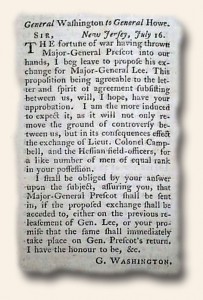
The “Gentleman’s Magazine” is a little gem packed with all the history one would want to find from the 18th century. Measuring about 5 by 8 inches and typically having about 40 pages they take up very little room in a collection. But best of all it is an accessible title, and at prices far below what would be found in comparable American & British newspapers of the same period.
There can be little excuse for holding back on buying the best events in American history if one is willing to add this famous & successful title to their collection. And there certainly will be a time when even this title will become very scarce as others discovery it as the little gem just begging to be collected.
Note: Rather than include an endless number of (annoying) links above, if you have interest in any of the topics discussed, simply go to the following link and enter the topic into the search field: www.RareNewspapers.com
Jack the Ripper’s Identity Revealed?
September 27, 2013 by GuyHeilenman · 1 Comment
While many are familiar with Jack the Ripper and are aware that his actual identity has never been confirmed, what may be surprising to some is how many “false alarms” have surfaced over the years. William Henry Bury is such an individual… or is he? An internet search will return much concerning this potential “Ripper”. I wonder if this case will ever be resolved to any degree of certainty??? Please enjoy the following report found in the Kansas City Daily Journal for February 12, 1889:
Print date for the Gentleman’s Magazine…
July 23, 2012 by TimHughes · Leave a Comment
 Actual printing dates of monthly magazines have always been difficult to establish, but some times dated news reports will give some indication. An advertisement for the Gentleman’s Magazine in the “Daily Post-Boy” of London, September 4, 1732, provides a valuable clue for the earliest issues of this title (it began publishing in 1731). Note that the advertisement has at the top: “September 2 was published…The Gentleman’s Magazine…for August, 1732…”. So at least during the early years of this magazine’s existence it printed a few days after the end of the month.
Actual printing dates of monthly magazines have always been difficult to establish, but some times dated news reports will give some indication. An advertisement for the Gentleman’s Magazine in the “Daily Post-Boy” of London, September 4, 1732, provides a valuable clue for the earliest issues of this title (it began publishing in 1731). Note that the advertisement has at the top: “September 2 was published…The Gentleman’s Magazine…for August, 1732…”. So at least during the early years of this magazine’s existence it printed a few days after the end of the month.
Another interesting tidbit is provided in this advertisement as well. We knew that the first several issues of the first year of “Gentleman’s Magazine” printed at least six editions, as some were noted as such on the title/contents page, but we never knew when they were reprinted. Note the very bottom of this advertisements mentions: “…Where may be had, The former Numbers, except Numb 1 and Numb. II which will be republished a 4th Time in a few days.” This indicates that the fifth edition of the January and February, 1731 issues were printed in the first week of September, 1732.
Jack the Ripper… on Pinterest
July 20, 2012 by GuyHeilenman · Leave a Comment
Jack the Ripper may very well be the most infamous serial killer in World History. While others may have murdered more people, the terror he caused to what was arguably the most recognized city of the time is 2nd to none. While authentic reports are hard to come by, The Times (London) did an excellent job of following the case. At Timothy Hughes Rare & Early Newspapers we’ve put together a set of images which help to tell the story, arranged chronologically, as the readers of the day would have read about it. I’d like to say enjoy…, but somehow such a term doesn’t sound fitting. The images may be viewed via Pinterest at: Jack the Ripper on Pinterest
The Traveler… going through withdrawal… setting an example…
May 7, 2012 by The Traveler · Leave a Comment
Today I found myself in London with the London Gazette dated May 8, 1712. I found that they had a reward for the apprehension of a gentleman by the name of Charles Guill. Mr. Guill “has belonged to the Bank of England, from whose Service he withdrew himself on the 3d Instant, with several Exchequer-Bills and the following Bank Notes…”. The article also provides a very interesting detail of his appearance and attire as well as the reward for his apprehension.
Another brief article is of the punishment a Robert Kingston received from pretending to be two other persons. He was sentenced to stand in the Pillory (stockades) on Tower-hill, which is where the executions were held. He was “to deter others from the like Practices”. He may have been setting an example for others, but I bet he was thinking that he was grateful that he had not received the punishment of those on Tower-hill!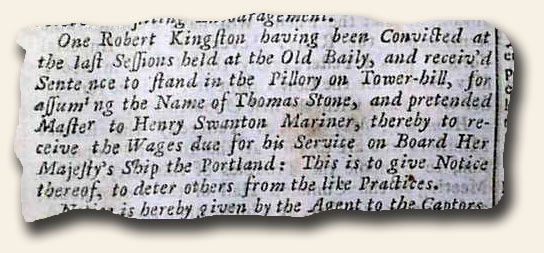
~The Traveler
The Traveler… wanted for murder… new regulations established…
January 23, 2012 by The Traveler · Leave a Comment
Today I journeyed to The Post Boy dated January 24, 1712 where I found there was a “wanted” man. The back page of this singlesheet newspaper was clearing the air on the false reports of the escape of Mr. Mackartney to Holland, “for he has never been on that side of the  Water since the Murder he committed…” This continued with a Royal Proclamation being issued for his capture along with the a 300 pound reward as he had been found to have committed the murder of James Duke of Hamilton and Brandon, and also with aiding and assisting the Lord Mohun to commit the murder of the Duke.
Water since the Murder he committed…” This continued with a Royal Proclamation being issued for his capture along with the a 300 pound reward as he had been found to have committed the murder of James Duke of Hamilton and Brandon, and also with aiding and assisting the Lord Mohun to commit the murder of the Duke.
While researching this incident further, I found the following information through Wikipedia… “In 1712, two years after Mohun’s Whig party had been heavily defeated in an election, the Duke of Hamilton was given the post of special envoy to Paris. Also at this time Mohun’s legal dispute with Hamilton over his inheritance of the Macclesfield estate was going badly. Shortly before Hamilton left for France, Mohun challenged him to a duel which was fought on 15 November in Hyde Park. Hamilton was killed during the fight by Mohun’s second, George MacCartney, after he had mortally wounded Mohun during the duel; Mohun died from his wounds shortly afterwards. This bloody duel was made immortal by William Makepeace Thackeray in his novel The History of Henry Esmond. The injuries suffered by the two men were so horrific that the government passed legislation banning the use of seconds in such duels. Also as a result swords were replaced as the weapons of choice in duel by the pistol, which tended to result in shorter and less bloody fights.”
Enjoy!
~The Traveler
The Traveler… promise to pay…
December 19, 2011 by The Traveler · Leave a Comment
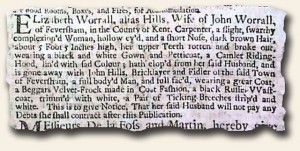 Today I found myself in London, England with the Post-Boy dated December 20, 1711. I also found that even with traveling back three hundred years, a portion of this paper would fit right into today’s newsstands. An article on the front page of this issue was the reporting “…to Bribe an honest member of the Church of England, to vote against the interest of that church, and his own conscience…”. The text of the “promise to pay” note is included in the article as well.
Today I found myself in London, England with the Post-Boy dated December 20, 1711. I also found that even with traveling back three hundred years, a portion of this paper would fit right into today’s newsstands. An article on the front page of this issue was the reporting “…to Bribe an honest member of the Church of England, to vote against the interest of that church, and his own conscience…”. The text of the “promise to pay” note is included in the article as well.
On the back page of this issue also contains a notice posted by a husband, stating that he would no longer be responsible for his wife’s debts. The description of his wife is very interesting!!
Until next year, I wish you all a very Merry Christmas and a Happy New Year!
~The Traveler
The Traveler… times at odds… three shots, but not dead…
July 11, 2011 by The Traveler · Leave a Comment
 Today I decided to travel back a little further than I have been of recent. Within the “The Post Boy” dated July 10, 1711, I found that it seemed that most of Europe was at odds with each other. The news from Paris, Lisbon, Genoa, Turin, Milan, Warsaw, Vienna and Hague all were dealing in some type of army and/or war activity.
Today I decided to travel back a little further than I have been of recent. Within the “The Post Boy” dated July 10, 1711, I found that it seemed that most of Europe was at odds with each other. The news from Paris, Lisbon, Genoa, Turin, Milan, Warsaw, Vienna and Hague all were dealing in some type of army and/or war activity.
A correspondence from Dover is of which a Privateer “had 3 small Shots in his Body, but was not dead; that only 3 of the Privateers engag’d him, and a great many are kill’d on both sides, the 3 Privateers had 300 Men each.”
Even with all that is occurring in our lives today, I’m thankful that we don’t live in the 18th century…
~The Traveler
Entry point to the Rare Newspapers Collectible… 18th Century…
February 3, 2011 by GuyHeilenman · Leave a Comment
Over the past month the History’s Newsstand Blog has explored the lower-end entry points into the hobby of collecting rare and early newspapers. This next installment takes us back to the 18th century. The further we move back in time the higher (price-wise) is the entry point. One of the common ways to keep your early (into the hobby) 18th century collecting budget under control is to start by collecting newspapers/magazines from England. Typically, reports on American affairs found within British publications cost as little as 1/10 (and sometimes even less percentage-wise) than the corresponding reports in American issues. With this in mind…
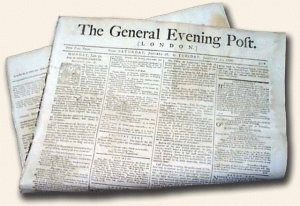 The following selection provides a glimpse of the wide variety of 18th century issues available valued at $25* and under. Many more exist on the Rare Newspapers’ website, but others can be found throughout the collectible community as well. The item numbers for each are linked to corresponding images.
The following selection provides a glimpse of the wide variety of 18th century issues available valued at $25* and under. Many more exist on the Rare Newspapers’ website, but others can be found throughout the collectible community as well. The item numbers for each are linked to corresponding images.
The oldest newspaper in the world…
120436 THE LONDON GAZETTE, England, dates ranging from 1726 to 1730 – This is the oldest continually published newspaper in the world, having begun in 1665 and is still being published today. Reporting is almost entirely concerned with Parliamentary items and European news with some advertisements near the back of the issue. $18.00*
From Pre-Revolutionary War England…
121059 THE ST. JAMES CHRONICLE; OR, THE BRITISH EVENING POST, London, England, 1767. Nice engraving in the masthead makes this a displayable issue. Various news of the day and a wealth of ads, from not long before the outbreak of the Revolutionary War. $18.00*
From Post-Revolutionary War England…
208968 THE GENERAL EVENING POST, London, 1792 A nice “typical” folio-size newspaper of 4 pages from the 18th century. There is a wealth of news of the day on the front page and inside pages with some ads scattered throughout as well. $18.00*
By the town critic…
121100 THE CONNOISSEUR, London, 1755. See the photo below for an example of this title from our archives. An uncommon and early title “By Mr. Town, Critic & Censor General” as noted in the masthead. Done in editorial format. $20.00*
From 18th century Scotland…
208447 THE EDINBURGH EVENING COURANT, Scotland, 1785. A nice 18th century Scottish newspaper with the entire front page taken up with ads, with various news of the day on the inside pages. Some of the ads have illustrations as well. Complete in 4 pages, partial red-inked tax stamp on the front page, folio size, some light browning or dirtiness, but in generally nice condition. $20.00*
Additional issues priced at $25* and under may be viewed at: Entry Level Newspapers
* All prices shown were valid as of the release date of this post.
View the following to explore the History’s Newsstand Blog’s featured posts on the upper end of the collectible: “Prices Realized” and “Most Collectible Issues“.
Ben Franklin displays his wit…
August 14, 2010 by TimHughes · Leave a Comment
The December 11, 1775 issue of the “Hampshire Chronicle” from Southampton, England, includes a witty note from Ben Franklin to a friend in London, which appeared in several newspapers of the day. By his mind, the Revolutionary War was not going to be won by England through attrition.